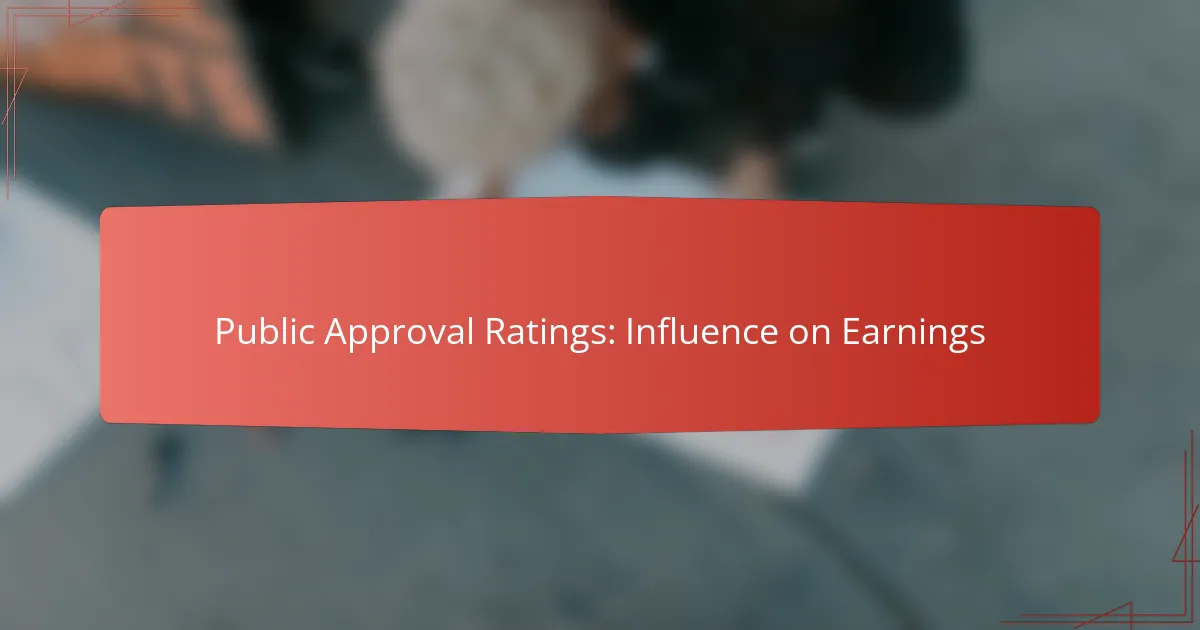Public approval ratings play a crucial role in determining corporate earnings by affecting both investor confidence and consumer behavior. When approval ratings are high, companies often experience increased sales and stock prices, whereas low ratings can lead to diminished trust and financial setbacks. Understanding the factors that influence these ratings, such as media coverage and economic conditions, is essential for businesses aiming to enhance their public image and, consequently, their financial performance.
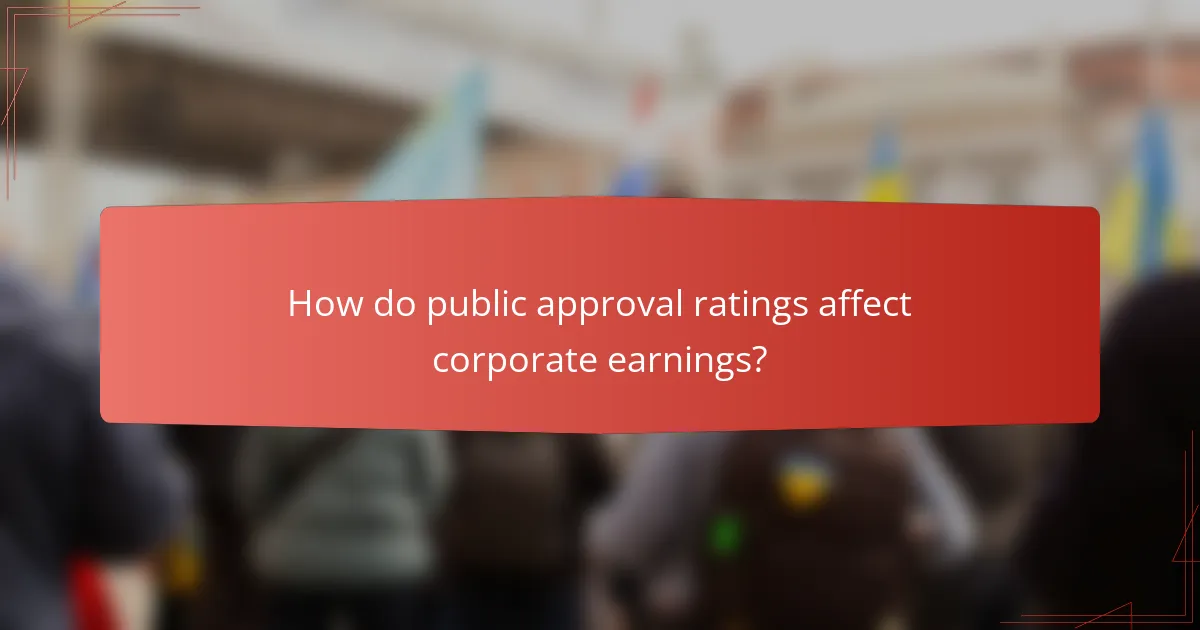
How do public approval ratings affect corporate earnings?
Public approval ratings significantly influence corporate earnings by shaping investor perceptions and consumer behavior. High approval ratings can lead to increased sales and stock prices, while low ratings may result in decreased trust and financial performance.
Direct correlation with stock performance
Public approval ratings often correlate directly with stock performance. When a company enjoys high approval ratings, investors tend to view it as a stable and promising entity, leading to increased stock prices. Conversely, declining approval can trigger sell-offs, resulting in lower stock valuations.
For example, a company with a strong public image may see its stock rise by double digits following positive ratings, while a significant drop in approval could lead to a decline of similar magnitude. Investors should monitor these ratings as part of their decision-making process.
Impact on consumer trust and spending
Public approval ratings play a crucial role in shaping consumer trust and spending habits. High ratings often indicate a company’s reliability and quality, encouraging consumers to spend more. This increased consumer confidence can translate into higher sales and revenue.
For instance, brands with favorable public perception may experience a surge in sales during product launches, while those with negative ratings might struggle to attract customers. Companies should actively manage their public image to maintain consumer trust and drive spending.
Influence on investor sentiment
Investor sentiment is heavily influenced by public approval ratings, as they reflect the overall health and stability of a company. Positive ratings can lead to increased investment, while negative ratings may cause hesitation or withdrawal from potential investors.
Investors often assess public approval as a key indicator of future performance. A company that consistently maintains high approval ratings is likely to attract more long-term investors, while those with fluctuating or low ratings may find it challenging to secure funding. Regularly evaluating public sentiment can provide valuable insights for investment strategies.
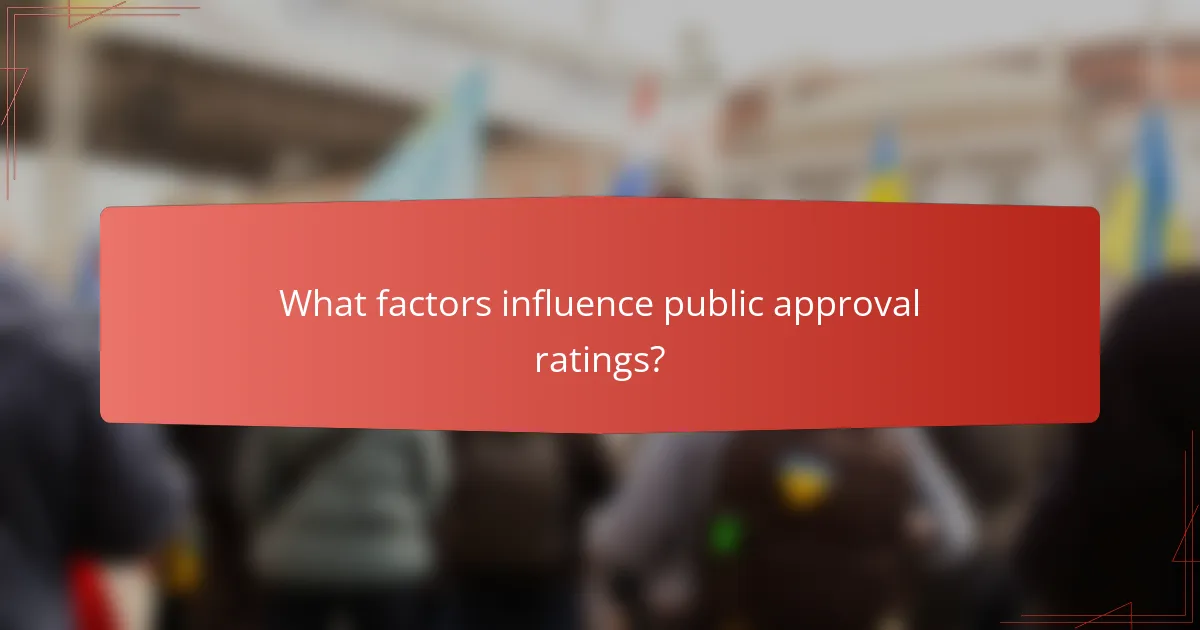
What factors influence public approval ratings?
Public approval ratings are influenced by various factors, including media coverage, political events, and economic performance. These elements shape how the public perceives leaders and their effectiveness, impacting their overall approval.
Media coverage and public perception
Media coverage plays a crucial role in shaping public perception of leaders and policies. Positive media portrayals can enhance approval ratings, while negative coverage can lead to declines. For instance, extensive coverage of a successful policy initiative can boost a leader’s image, whereas scandals or controversies can overshadow achievements.
It’s essential for leaders to engage proactively with the media to manage their narratives. Regular press briefings, social media engagement, and transparency can help maintain a favorable public image. However, leaders should be cautious of sensationalist reporting that may distort public perception.
Political events and scandals
Political events, particularly scandals, can significantly influence public approval ratings. A major scandal can lead to a rapid decline in support, as seen in various political contexts globally. For example, a corruption scandal may result in a drop of several percentage points in approval ratings within weeks.
To mitigate the impact of such events, leaders should focus on crisis management strategies, including timely responses and accountability measures. Engaging with constituents and addressing concerns directly can help rebuild trust and stabilize approval ratings after a scandal.
Economic indicators and performance
Economic indicators, such as unemployment rates and GDP growth, are closely linked to public approval ratings. Generally, when the economy is performing well, approval ratings tend to rise; conversely, economic downturns can lead to significant declines in support. For instance, a drop in unemployment from high levels can positively influence public sentiment.
Leaders should monitor economic trends and communicate effectively about their administration’s role in economic performance. Highlighting job creation initiatives or economic recovery plans can help bolster approval ratings during challenging economic times. Regular updates on economic progress can reinforce public confidence in leadership.
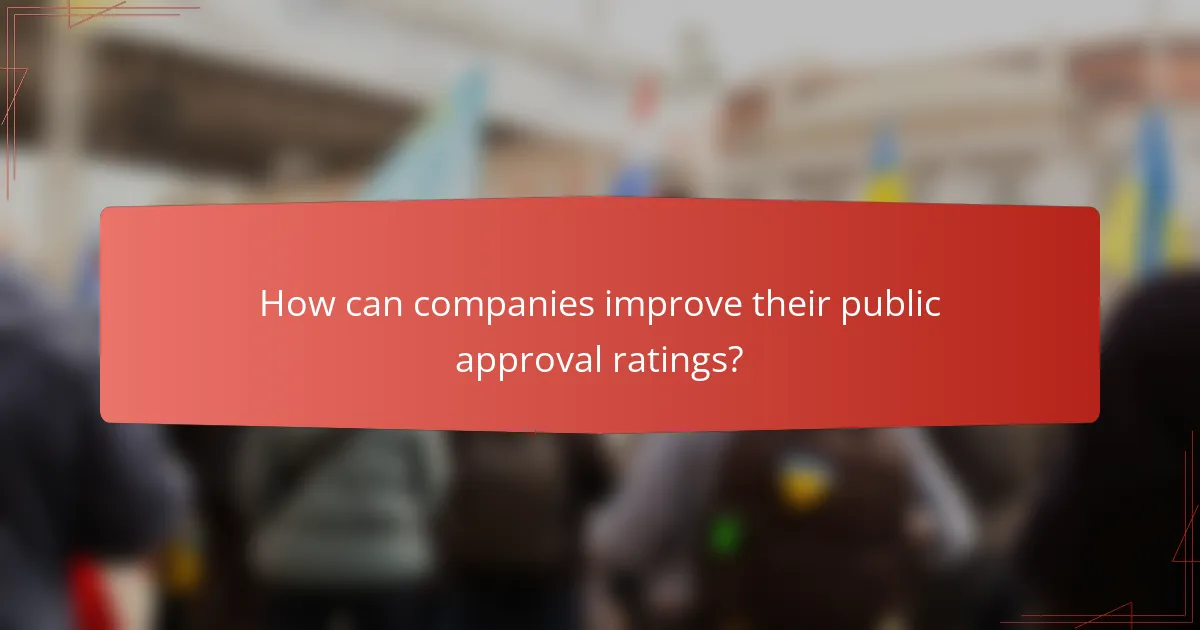
How can companies improve their public approval ratings?
Companies can enhance their public approval ratings by implementing effective communication strategies, engaging in corporate social responsibility initiatives, and actively involving stakeholders. These approaches not only foster trust but also create a positive public image that can influence earnings.
Effective communication strategies
Clear and transparent communication is essential for improving public approval ratings. Companies should regularly share updates about their operations, values, and goals through various channels, including social media, press releases, and community events.
Utilizing storytelling techniques can also enhance engagement. By sharing authentic stories about their impact on customers and communities, companies can create emotional connections that resonate with the public.
Corporate social responsibility initiatives
Engaging in corporate social responsibility (CSR) initiatives can significantly boost public perception. Companies should identify social or environmental issues relevant to their operations and invest in programs that address these challenges, such as sustainability efforts or community development projects.
For example, a company might allocate a portion of its profits to local charities or implement eco-friendly practices in its supply chain. These actions demonstrate a commitment to societal well-being, which can enhance approval ratings.
Engagement with stakeholders
Active engagement with stakeholders, including customers, employees, and community members, is crucial for improving public approval ratings. Companies should seek feedback through surveys, focus groups, and public forums to understand stakeholder concerns and expectations.
Regularly addressing stakeholder feedback and incorporating it into business practices can build trust and loyalty. Additionally, fostering a culture of inclusivity and responsiveness can further enhance public perception and approval ratings.

What is the relationship between public approval ratings and market trends?
Public approval ratings can significantly influence market trends, as they often reflect consumer confidence and political stability. High approval ratings typically correlate with positive market performance, while low ratings may lead to increased uncertainty and volatility.
Correlation with industry performance
Public approval ratings can directly impact specific industries, particularly those heavily influenced by government policies, such as healthcare, energy, and finance. For example, a government with high approval may implement favorable regulations that boost stock prices in these sectors.
Conversely, declining approval ratings can lead to policy changes that negatively affect industry performance. Investors should monitor approval ratings closely, as shifts can signal potential investment risks or opportunities within certain sectors.
Effects on market volatility
Market volatility often rises in response to fluctuating public approval ratings, particularly during election cycles or significant political events. When approval ratings drop, uncertainty can lead to rapid sell-offs or increased trading volumes as investors react to perceived risks.
To mitigate risks associated with volatility, investors should consider diversifying their portfolios and staying informed about political developments. Understanding the broader implications of public sentiment can help in making more strategic investment decisions during turbulent times.
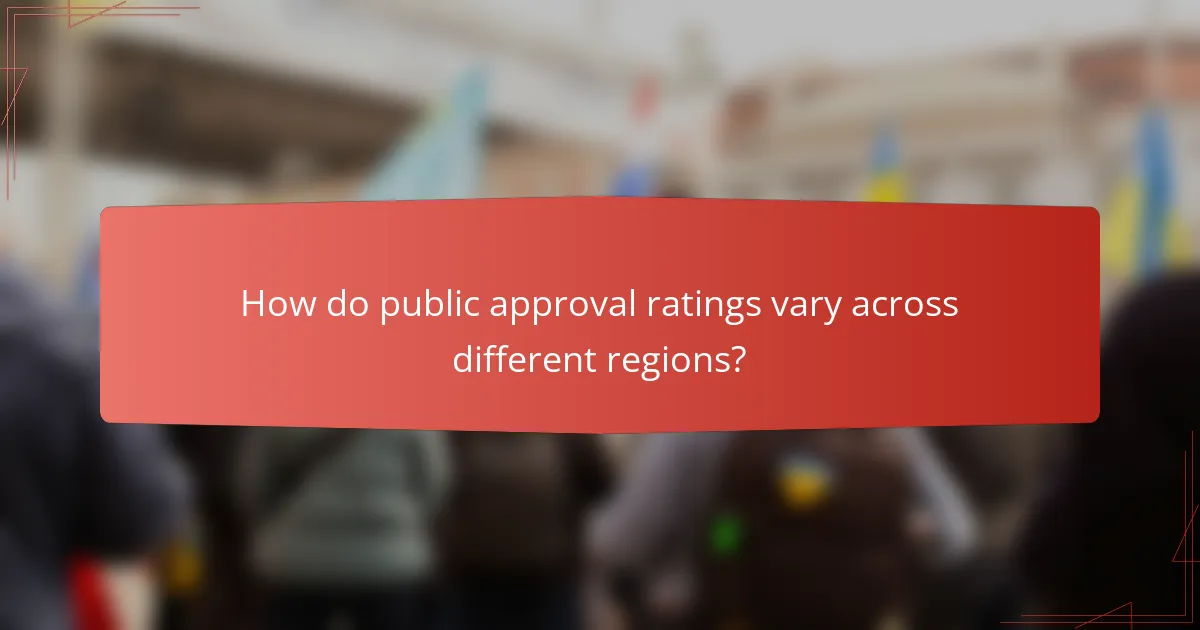
How do public approval ratings vary across different regions?
Public approval ratings can differ significantly across regions due to various factors, including economic conditions and cultural influences. Understanding these variations is crucial for businesses and policymakers as they navigate regional markets and public sentiment.
Regional economic conditions
Economic conditions play a vital role in shaping public approval ratings. Regions experiencing economic growth often show higher approval ratings for government officials and policies, while areas facing economic downturns may reflect lower approval due to dissatisfaction with leadership. For instance, countries in Western Europe, like Germany and France, typically have higher approval ratings during periods of economic stability.
Additionally, local employment rates, inflation, and income levels can impact public sentiment. Regions with low unemployment and rising wages tend to foster positive perceptions of leadership, while those with high unemployment may see a decline in approval ratings.
Cultural influences on perception
Cultural factors significantly affect how public approval ratings are perceived and interpreted. In collectivist cultures, such as those in many Asian countries, public opinion may prioritize community welfare over individual achievements, leading to different approval dynamics compared to individualistic cultures like the United States.
Moreover, cultural attitudes towards authority and governance can shape approval ratings. For example, in Scandinavian countries, there is often a high level of trust in government institutions, resulting in consistently high approval ratings. In contrast, regions with historical distrust towards government may exhibit fluctuating approval based on current events or scandals.

What tools can be used to measure public approval ratings?
Public approval ratings can be measured using various tools, primarily polling organizations and social media sentiment analysis tools. These methods provide insights into public opinion and can influence business and political decisions.
Polling organizations like Gallup
Polling organizations, such as Gallup, conduct surveys to gauge public sentiment on various issues, including political approval ratings. They typically use random sampling and structured questionnaires to ensure a representative cross-section of the population.
When interpreting results from polling organizations, consider the margin of error, which usually ranges from 2-5%. This helps to understand the reliability of the data and its potential impact on decision-making.
Social media sentiment analysis tools
Social media sentiment analysis tools analyze online conversations to assess public opinion in real-time. These tools use algorithms to evaluate the tone of posts, comments, and shares across platforms like Twitter and Facebook.
While these tools can provide immediate insights, they may also include biases based on the demographics of social media users. It’s essential to combine these insights with traditional polling data for a more comprehensive view of public approval ratings.
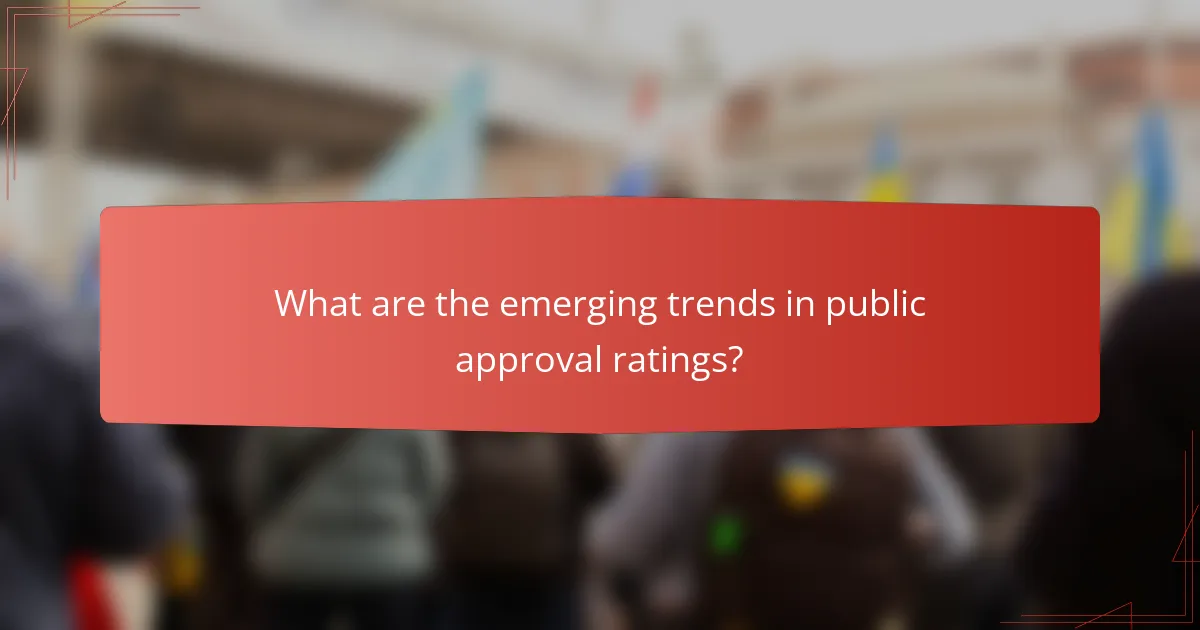
What are the emerging trends in public approval ratings?
Emerging trends in public approval ratings indicate a growing influence of social media and rapid information dissemination on public perception. These ratings are increasingly volatile, reflecting immediate reactions to political events, policies, and leadership styles.
Impact of Social Media on Approval Ratings
Social media platforms have transformed how public approval ratings are shaped and perceived. Instant feedback and viral trends can lead to swift changes in public sentiment, often driven by trending topics or influential figures. For instance, a single tweet can significantly boost or diminish a politician’s approval rating within hours.
Organizations tracking these ratings must consider the role of social media analytics, as they provide real-time insights into public opinion. Monitoring platforms like Twitter and Facebook can help identify shifts in approval ratings before traditional polling methods catch up.
Regional Variations in Approval Ratings
Public approval ratings can vary significantly across different regions, influenced by local issues, cultural factors, and economic conditions. For example, a government may enjoy high approval in urban areas while facing criticism in rural regions due to differing priorities and experiences.
Understanding these regional variations is crucial for political campaigns and businesses alike. Tailoring messages to resonate with local sentiments can enhance engagement and improve overall approval ratings.
Long-term Trends vs. Short-term Fluctuations
While short-term fluctuations in approval ratings can be dramatic, long-term trends often reveal more stable patterns. Factors such as economic performance, major policy changes, and significant events like elections can create lasting impacts on public sentiment.
Analyzing these long-term trends helps organizations anticipate future shifts and adjust strategies accordingly. For instance, a steady decline in approval ratings over several months may indicate underlying issues that need addressing before they escalate.
